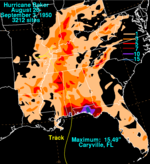1950 Atlantic hurricane season
| 1950 Atlantic hurricane season |

Season summary map
|
| Seasonal boundaries |
| First system formed |
August 12, 1950 |
| Last system dissipated |
November 12, 1950 |
| Strongest storm |
|
| Name |
Dog |
| • Maximum winds |
145 mph (230 km/h) |
| • Lowest pressure |
943 mbar (hPa; 27.85 inHg) |
| Seasonal statistics |
| Total depressions |
16 |
| Total storms |
16 |
| Hurricanes |
11 |
Major hurricanes
(Cat. 3+) |
6 |
| Total fatalities |
88 overall |
| Total damage |
$38.5 million (1950 USD) |
|
|
Atlantic hurricane seasons
1948, 1949, 1950, 1951, 1952
|
| Category 3 hurricane (SSHWS) |
|
|
| Duration |
August 12 – August 22 |
| Peak intensity |
125 mph (205 km/h) (1-min) ≤ 953 mbar (hPa) |
| Category 2 hurricane (SSHWS) |
|
|
| Duration |
August 18 – September 1 |
| Peak intensity |
105 mph (165 km/h) (1-min) ≤ 978 mbar (hPa) |
| Category 2 hurricane (SSHWS) |
|
|
| Duration |
August 21 – September 5 |
| Peak intensity |
110 mph (175 km/h) (1-min) ≤ 974 mbar (hPa) |
| Category 4 hurricane (SSHWS) |
|
|
| Duration |
August 30 – September 18 (Extratropical on September 12)
|
| Peak intensity |
145 mph (230 km/h) (1-min) ≤ 943 mbar (hPa) |
| Category 3 hurricane (SSHWS) |
|
|
| Duration |
September 1 – September 9 |
| Peak intensity |
120 mph (195 km/h) (1-min) ≤ 958 mbar (hPa) |
| Category 4 hurricane (SSHWS) |
|
|
| Duration |
September 8 – September 17 |
| Peak intensity |
140 mph (220 km/h) (1-min) 946 mbar (hPa) |
| Category 2 hurricane (SSHWS) |
|
|
| Duration |
September 27 – October 7 (Extratropical on October 5)
|
| Peak intensity |
110 mph (175 km/h) (1-min) 960 mbar (hPa) |
| Tropical storm (SSHWS) |
|
|
| Duration |
October 1 – October 4 |
| Peak intensity |
45 mph (75 km/h) (1-min) ≤ 1007 mbar (hPa) |
| Category 2 hurricane (SSHWS) |
|
|
| Duration |
October 8 – October 11 |
| Peak intensity |
105 mph (165 km/h) (1-min) 976 mbar (hPa) |
The 1950 Atlantic hurricane season was the first year in the Atlantic hurricane database (HURDAT) that storms were given names in the Atlantic basin. Names were taken from the Joint Army/Navy Phonetic Alphabet, with the first named storm being designated "Able", the second "Baker", and so on. It was an active season with sixteen tropical storms, with eleven of them developing into hurricanes. Six of these hurricanes were intense enough to be classified as major hurricanes—a denomination reserved for storms that attained sustained winds equivalent to a Category 3 or greater on the present-day Saffir–Simpson scale. One storm, the twelfth of the season, was unnamed and was originally excluded from the yearly summary, and three additional storms were discovered in re-analysis. The large quantity of strong storms during the year yielded, prior to modern reanalysis, what was the highest seasonal accumulated cyclone energy (ACE) of the 20th century in the Atlantic basin; 1950 held the seasonal ACE record until broken by the 2005 Atlantic hurricane season. However, later examination by researchers determined that several storms in the 1950 season were weaker than thought, leading to a lower ACE than assessed originally.
The tropical cyclones of the season produced a total of 88 fatalities and $38.5 million in property damage (1950 USD). The first officially named Atlantic hurricane was Hurricane Able, which formed on August 12, brushed the North Carolina coastline, and later moved across Atlantic Canada. The strongest hurricane of the season, Hurricane Dog, reached the equivalent of a Category 4 hurricane on the Saffir–Simpson scale, and caused extensive damage to the Leeward Islands. Two major hurricanes affected Florida: Easy produced the highest 24-hour rainfall total recorded in the United States, while King struck downtown Miami as a Category 4 hurricane and caused $27.75 million (1950 USD) of damage. The two major landfalls made the 1945–1950 period the only five-year period to feature five major hurricane landfalls in the United States—a record that held until tied in 2000–2005. The last storm of the year, an unnamed tropical storm, dissipated on November 13.
...
Wikipedia















